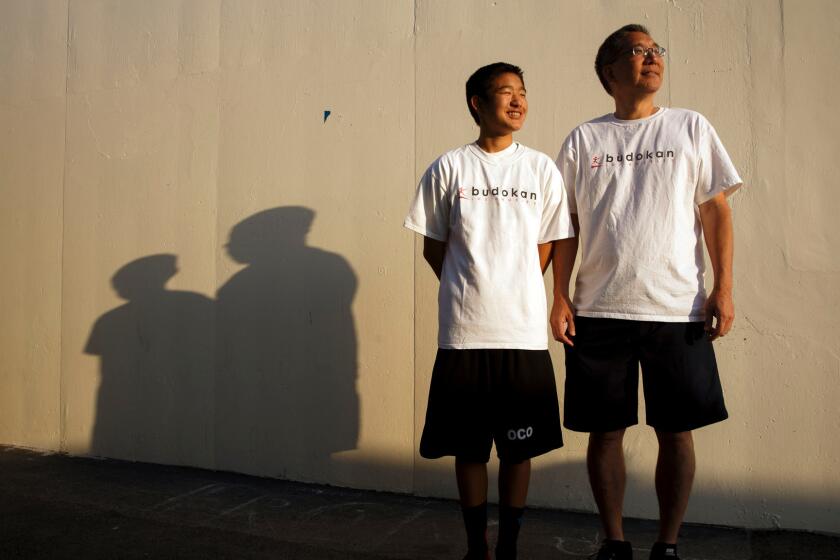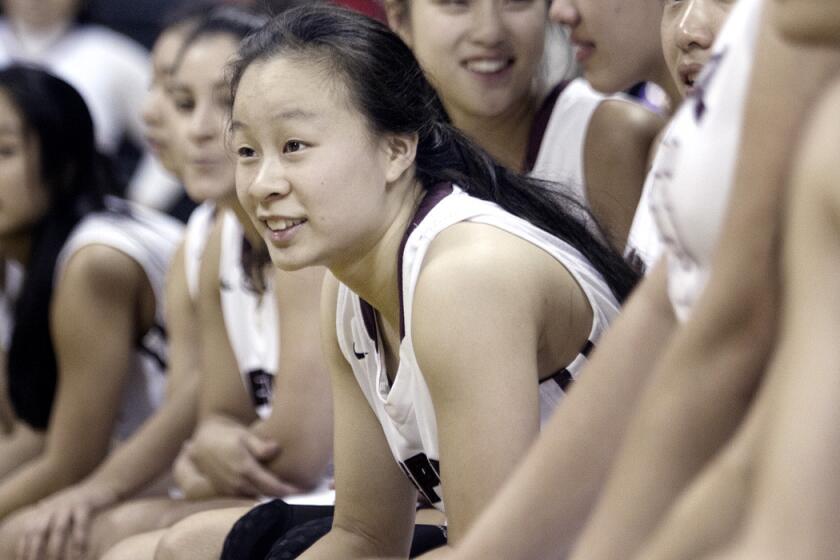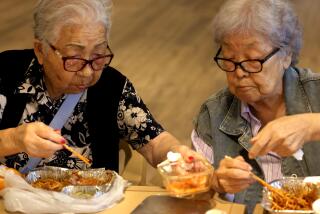Finally, a gym of their own in Little Tokyo
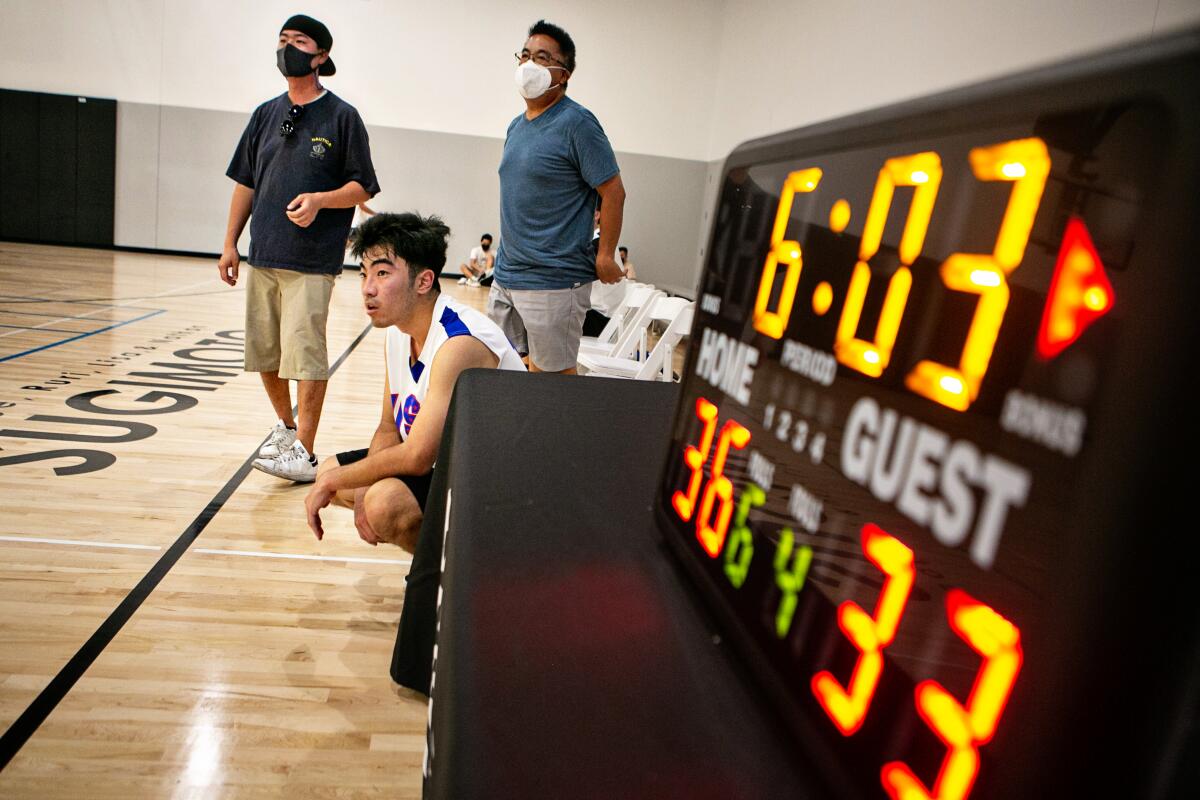
- Share via
The crowd at the Little Tokyo gym roared as the basketball player, his team down a dozen points, dodged a defender, spun and hit a fadeaway shot.
Despite the flashy drive, the contest on a Sunday night in June was mainly one-sided, with a final score of 73-33.
For players on both teams and their supporters, the outcome was not what mattered most. The game — Japanese American teenagers playing hoops at a new athletic facility in Los Angeles’ most iconic Japanese neighborhood — was a victory for everyone involved.
The Terasaki Budokan gym and community center, which will host sports leagues, after-school programs, classes for senior citizens and cultural events, opened in June after a $35-million fundraising effort and decades of delays.
For a Japanese community that sees little new immigration and whose youngest members are fourth- or fifth-generation Americans, the Budokan will be a gathering place in a historic neighborhood threatened by assimilation and gentrification.
Older Japanese Americans hope it will draw young people from across Southern California to connect with one another and with their Japanese roots. Perhaps after basketball or karate, they will roam the Japanese American National Museum or grab mochi at the 118-year-old confectionery Fugetsu-Do.
The influx of visitors could provide a vital boost to Little Tokyo’s traditional Japanese stores and restaurants, which are at risk of displacement by chain cafes and hip sneaker shops after suffering through the worst of the COVID-19 pandemic.
“If you think of a community where young people never come, that community will eventually die,” said Bill Watanabe, 77, former director of the Little Tokyo Service Center and a driving force behind the Budokan project. “But if young people come who are ethnic and say, ‘Wow, Little Tokyo is part of my home as well,’ then they’ll care about the neighborhood. That’s why Little Tokyo has lasted this long — because people have cared about it.”
The basketball players that night were mostly Yonsei — fourth-generation Japanese American. After the game, some dined at a Little Tokyo ramen shop.
“I think people my age will come here more now, because basketball is what brings a lot of us young people together,” said Sarah Johnson, 21, who is Gosei — fifth generation — and played in one of Sunday night’s games. “We can all kind of centralize in Little Tokyo.”

The Budokan has been nearly 30 years in the making.
At a 1994 community meeting in Little Tokyo, attendees brainstormed about new projects. Some Japanese American youths drew a picture of a basketball court, said Scott Ito, project director for the Budokan.
That same year, Watanabe had heard about a gym in San Francisco’s Japantown that was a hub for multiple generations of Japanese Americans.
“It just dawned on me,” Watanabe said. “That’s what we need in Little Tokyo — something that would draw young people.”
At the time, basketball games, even official intramural ones, were played in the middle of the street or on the sidewalk, said former L.A. City Councilwoman Jan Perry, who played a key role in securing a site for the Budokan.
Little Tokyo was full of empty parking lots and dull, quiet evenings, Ito recalled.
“It got really ugly here,” said Brian Kito, the owner of Fugetsu-Do. “I don’t think many people realize how close this area was to just collapsing.”
Japanese immigrants, shut out from many other neighborhoods because of racial discrimination, settled in what became Little Tokyo in the late 19th century, said Karen Umemoto, chair of the Asian American Studies Center at UCLA. Then came World War II, when the U.S. government rounded up Japanese Americans and sent them to concentration camps.
After the war, some returned to Little Tokyo. As housing segregation eased up, Boyle Heights, Monterey Park, San Gabriel and Orange County became popular destinations.
Today, relatively few Japanese Americans live in Little Tokyo. Many long-standing Japanese-owned businesses were already struggling before the pandemic, with some giving way to trendier stores.
But the neighborhood has rebounded as an Instagram-friendly location for Hiroshima-style cabbage pancakes and Hokkaido-style ramen.
In the 1990s, it was not clear that Little Tokyo would survive, said Chris Komai, a longtime sports editor for the Japanese American newspaper Rafu Shimpo.
The Terasaki Budokan was Watanabe’s “major effort to [preserve the neighborhood], because if we didn’t, Little Tokyo could die,” he said.
There’s no particular reason for Alan Kosaka to come to Little Tokyo.
First, they had to secure a site. They spent years focused on a property in the heart of Little Tokyo. But they faced resistance from Rita Walters, a councilwoman from 1991 to 2001, who said she wanted the area turned into green space.
The Japanese American National Museum, the East West Players theater and the Go for Broke Monument to Japanese American veterans of World War II were nearby. Representatives of those institutions wanted the site used for an “art park.”
“There was never any opposition to the project itself. It was just the location,” Perry said.
A decade passed, and the Budokan was still searching for a home.
Finally, in 2011, the L.A. City Council approved a new site proposed by Perry, on South Los Angeles Street between East 2nd and 3rd streets.
Fundraising began in earnest that year, with a $1-million gift from the George and Sakaye Aratani Family Foundation.
Over the next few years, the project received millions of dollars in grants from the city and county. It was anchored by a $3.5-million donation from the Terasaki Family Foundation.
Groundbreaking came in August 2017; construction lasted three years. Because of the coronavirus, a virtual opening ceremony was held last summer, with in-person festivities put off until next year.
The Budokan — it translates to “martial arts hall” — was named after the Nippon Budokan, built to host judo events during the 1964 Tokyo Summer Olympics. The gym is open for private rentals, including basketball tournaments and martial arts practices, and has hosted volleyball tournaments, dance workshops and tai chi and yoga for seniors. There will soon be open gym hours for the public.
Assemblyman Miguel Santiago (D-Los Angeles), whose district includes Little Tokyo, has secured $300,000 from the state budget for programs at Budokan.
A few blocks away, the restaurant Azay has seen a boost from catering events at Budokan, said co-owner Jo Ann Hirose, a second-generation Little Tokyo business owner. Azay, which she owns with her husband, Akira Hirose, is in the space formerly occupied by her father’s hardware store.
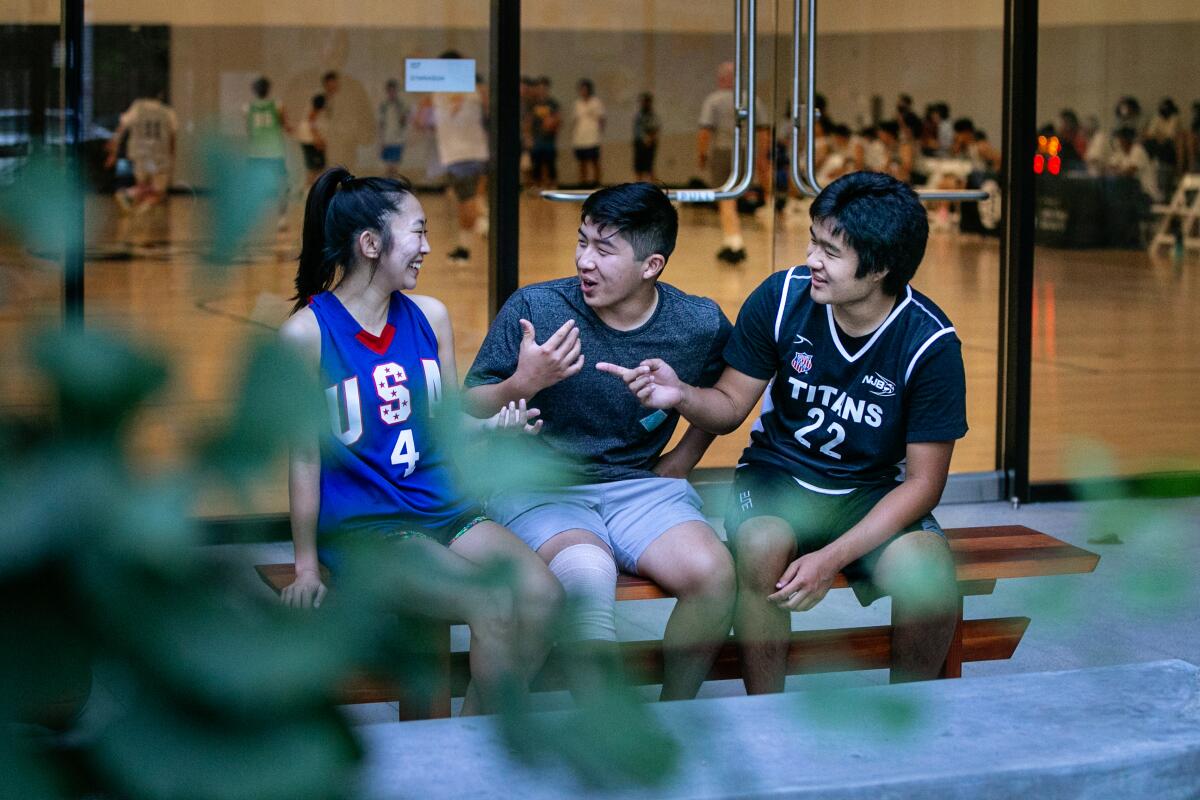
Aidan Kosaka, 19, organized the Sunday-night youth basketball league at Budokan (and played on the losing side of that 73-33 matchup). His father, Alan Kosaka, was the chair of Budokan’s capital campaign.
Aidan’s grandfather lived in Little Tokyo and worked at Fugetsu-Do after being released from the Gila River internment camp in Arizona.
A fourth-generation Japanese American, Aidan didn’t visit Little Tokyo much because of the distance from his Orange County home. The Budokan is changing that.
“Through the vehicle of sports, we’re able to bring people back to Little Tokyo, back to celebrate their roots,” he said.
Youth basketball has a storied place in postwar Japanese American culture, cementing ties among young people and between generations. Many play in private leagues, and families drive hundreds of miles for tournaments. Players who honed their skills in the leagues have become stars in high school and beyond — especially point guards, short in stature and long in court sense.
Standing just 5 feet 3, Lauren Saiki was sometimes the smallest player on the basketball court.
Kosaka’s friend Matt Okazaki is a fourth-generation Japanese American who calls himself a “Twinkie,” someone who is ethnically Asian and culturally white. But Okazaki, 18, has played in Japanese American basketball leagues since he was in second grade.
“It’s just been a huge part of our lives, like a second family,” he said.
For 15-year-old Kyle Minami, the Budokan brings together basketball, boba and his Japanese American buddies, he said — “pretty much everything.”
More to Read
Sign up for Essential California
The most important California stories and recommendations in your inbox every morning.
You may occasionally receive promotional content from the Los Angeles Times.
